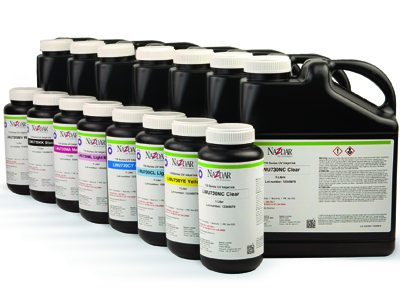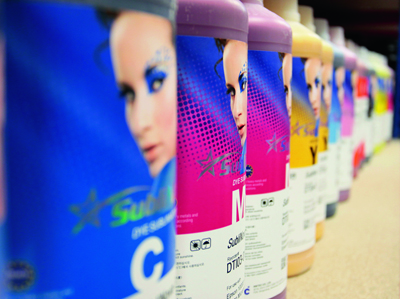Inktec develops inks for its own Jetrix printers, as well as selling aftermarket inks for other printers
There’s a wide choice of third party inks for wide format printers but is it a good idea to switch to an unknown ink, asks Nessan Cleary.
Just about every wide format printer vendor also supplies inks branded for those printers. These will have been tested to work with the printer in question as well as with the most common substrates. Where necessary, the ink formulation and the electronic controls for the printheads will have been tweaked to ensure the best performance, which is a good reason for using the manufacturer’s recommended inks.
But of course, those inks also come at a certain price so there’s an obvious temptation to look at third-party or aftermarket inks which may offer considerable savings. However, the printer will come with a warranty, which will be a major factor in keeping down the cost of servicing. Naturally, using third-party inks will void the warranty, and since it usually covers expensive items like replacement printheads, it’s usually best to stick with the vendor’s inks to maintain that cover, at least until the warranty on the printer has expired before switching ink suppliers. But there are several manufacturers offering third-party inks for use with wide-format printers, so what is the attraction?
No development debt
Ben Woodruff, UK sales manager for Inktec, opines, ‘I would say that the sole reason that any customers have switched is down to the cost benefit, because there could be a saving of 40-50% over the price of OEM ink.’ He says this is because most OEMs include part of the development cost of the printer in the price of the ink whereas an aftermarket ink supplier doesn’t have that overhead: ‘If you are an ink manufacturer it’s as easy to make ink for one printer as another.’
Mr Woodruff adds, ‘Third-party ink works best when the customer has some technical knowledge and when the machine is out of warranty. We offer a warranty for the ink so that it’s guaranteed not to damage the machinery that it’s intended for.’ However, he adds, ‘Service contracts for third-party inks are probably not going to outdo the manufacturers’ warranty because they have to have their own spare parts and engineers based on reasonable proximity to the customer.’
Inktec is in the unusual position of both selling third-party inks and having its own range of printers. The company started off as an ink manufacturer, making inks for original equipment suppliers as well as selling aftermarket inks direct to end-users. More recently, Inktec developed its own Jetrix range of printers for which, of course, the company recommends its own inks.
Mr Woodruff admits, ‘Having the Jetrix has opened our eyes. We went down the route of having a good warranty so that the customers would look at it as a five-year rather than a one-year partnership and made our service costs on the Jetrix as low as we could to remind customers of the advantage.’ He adds, ‘We have the same difficulty as anyone else selling aftermarket inks in that the customer gets a warranty with the machine and unless they are a really heavy user, the benefits of switching over aren’t great enough to lose the warranty.’
Inktec originates from South Korea, and Mr Woodruff points out, ‘In South Korea there’s no market for OEM ink so any machines sold will come with a competitive ink because customers want to choose the ink they use.’
No warranty woes
Some ink manufacturers have gone out of their way to overcome the warranty issue. Sun Chemical, for example, offers a full package of engineering and technical support. Tony Cox, business and marketing manager for Sun Chemical’s graphics and digital inks, says, ‘We can service the printer and replace heads. We have the ability to offer a warranty that is exactly the same as a OEM warranty.’
Sun Chemical makes OEM inks for various manufacturers and also offers a range of aftermarket solvent inks, though not for the same printers. Mr Cox says, ‘We match them to particular printers. Although multiple platforms have the same printheads, the colours are different, so in order to make the ink conversion very easy and so that they can use the colour profiles supplied with the machine we match the inks for colour.’

Tony Cox, business and marketing manager for Sun Chemical’s graphics and digital inks.
He says that the Sun Chemical will include all the standard colours to match those offered with the original printer but might not include all of the options, noting, ‘Sometimes there’s not a business case to justify the development work such as options introduced by the OEM like silver that haven’t really taken off.’
Mr Cox says that the performance has to be at least as good as the original ink, adding, ‘We try to make it easy for the customer to convert. If you can make the colour properties the same so that it jets and profiles equally, then you can build some advantages in like low odour which doesn’t affect the performance.’ But he says that the main priority is to achieve the same level of performance and colour, usually with the same colour profiles as the OEM ink but at a lower price, rather than extending the original performance.
Mr Cox says that although the main market is for older machines there are some customers that buy aftermarket inks for new ones, adding, ‘It’s possible for the customer to enjoy significant cost savings by using our ink right from day one and we can provide exactly the same level of warranty that the OEM can offer but at a reduced price.’
UV-curable options
Most of the third-party inks available are aimed at solvent printers with a much more limited choice for UV-curing alternatives. Sun Chemical, for example, makes a number of UV inks for OEMs but does not offer any aftermarket ones, which Mr Cox says is mainly to avoid any conflicts between the sales channel.
Tudor Morgan, systems marketing manager for Fujifilm Speciality Ink Systems, points out that the UV inks are also more complex to develop. He explains, ‘With solvent the drop size was very high – around 30 picolitres – and the materials range that we were looking at was very simple,
like vinyl or banner paper, which are quite simple materials to get things to adhere to. But with UV you have different types of materials so we are not really involved in LED or UV third-party ink systems.’
He adds that there’s less opportunity nowadays for a third-party UV ink, noting that there are more companies supplying UV wide format hardware which filters down to the price of OEM inks, explaining, ‘The pricing of the ink can make that machine very hard to sell, so the pricing for UV and LED is more competitive from the original manufacturers.’

Nazdar has released these 730 Series UV inkjet inks, which are suitable for a wide range of wide format printers
Another factor is that UV printers tend to be more expensive than solvent machines and are more complex to maintain, so the cost of the ink isn’t such a big proportion of the overall running cost.
However, there are some third-party UV inks available. Nazdar, for example, sells its 730 series, which includes CMYK, light cyan and light magenta, as well as white and clear colours and is available in one-, five- and eight-litre containers. It’s said to be suitable for a variety of printer models for applications such as banners, POP displays and backlit acrylic signage, and to have good edge-chipping resistance properties suitable for substrates that require router, knife- or die-cutting.
Converting the printer
Aside from cost savings, third-party inks can also be used to convert a printer to a different use. Perhaps the most common reason would be to convert a printer for use with dye sublimation inks. There’s an enormous choice of third-party dye sublimation inks and up until just a few years ago it was fairly common for textile users to take a solvent or aqueous ink printer and refill it with third-party dye sublimation inks.
However, most vendors now offer their own dye sublimation printers, complete with their own branded dye-sub inks, so this sort of conversion is now less common. Mr Cox says that converting machines between ink technologies is fraught with problems, noting, ‘It depends on the condition of the printer and its age. It’s not something that we generally encourage, because you can come up against unforeseen issues with high costs.’
Instead, most of the specialist dye sublimation ink vendors concentrate on industrial textile printers, while aftermarket dye sublimation inks such as Sun Chemical’s Sun Tex range are mainly aimed at machines that were designed for this sort of work.
Ultimately, switching to a third-party ink comes down to balancing the cost savings of that ink against the maintenance cost of the printer. There’s clearly a good case to be made for using these inks with solvent and dye sublimation printers, particularly amongst high volume ink users. It can also offer a useful way of squeezing an extra couple of years of service out of an older printer.





